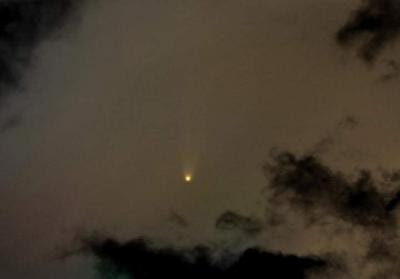A newfound comet is about to loop around the Sun and might offer skywatchers a rare and fantastic view. But comets are unpredictable, and this one has a wide range of possible outcomes, experts say. When Australian astronomer Robert McNaught announced Aug. 7 that he had discovered a faint comet on a photograph taken at the Siding Spring Observatory in New South Wales, it was a distant and inconspicuous object. But its orbital motion at once made it clear that this comet, officially catalogued as C/2006 P1, might grow very bright right about now.
When Australian astronomer Robert McNaught announced Aug. 7 that he had discovered a faint comet on a photograph taken at the Siding Spring Observatory in New South Wales, it was a distant and inconspicuous object. But its orbital motion at once made it clear that this comet, officially catalogued as C/2006 P1, might grow very bright right about now.
Comet McNaught's orbit indicates that it will sweep to within just 15.8 million miles (25.4 million kilometers) of the Sun on Jan. 12. This rather close approach—less than half the average distance of Mercury, the closest planet to the Sun—suggests the comet has the potential to briefly evolve into a bright object. The big question is, just how bright?
Brighter than Venus?
Recent estimates have ranged widely from magnitude +2.1 (about as bright as Polaris, the North Star) to a dazzling -8.8 (about 40 times brighter than Venus)!
[The lower the magnitude number, the brighter the object. The brightest stars in the sky are categorized as zero or first magnitude. Negative magnitudes are reserved for the most brilliant objects: the brightest star is Sirius (-1.4); the full Moon is -12.7; the Sun is -26.7. The faintest stars visible under dark skies are around +6.]
The reason for the great uncertainty stems from the fact that for the past few weeks the comet has been positioned at such a relatively small angular distance from the Sun in the sky that it has been extremely difficult to get good measurements of its brightness. Now, with a little over a week to go before the comet makes its closest approach to the Sun (called perihelion), just how bright it may ultimately get and how long a tail may develop remain to be seen.
Predicting a newly discovered comet's brightness has proven historically to be difficult, especially around the time of perihelion.
Spot it now
This is the 31st comet to bear McNaught's name and at time of discovery, it was no brighter than magnitude 17—far to dim to see with the naked eye.
Observers have followed its gradual brightening as its distances from Sun and Earth decreased. It's currently both a morning and evening object, visible very low near the east-southeast horizon about 30 to 40 minutes before sunrise and very low near the west-southwest horizon about 30 to 40 minutes after sunset.
During this upcoming week, prospective observers should seek the most favorable conditions possible. Even a bright comet can be obliterated by thin horizon clouds, haze, humid air, smoke, twilight glow, city lights, or moonlight. Binoculars are strongly recommended for locating it.
But the past few days, reports suggest that Comet McNaught is becoming easier to sight even through the bright twilight glow.
--more--
*Space.com

No comments:
Post a Comment
Contact The Wizard!
(he/him)